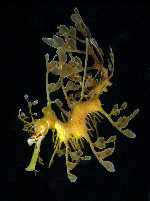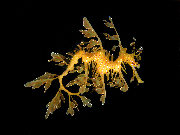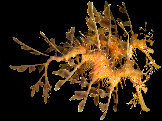Leafy Seadragon
(Phycodurus eques)
Family: Syngnathidae
"Majestic,
delicate and beautiful; it's hard not to be captivated by the sighting of a
Leafy Seadragon"
 My
first and only encounter with Leafy Seadragon's occurred under Rapid Bay Jetty
in South Australia in 2004. My buddy (Aengus Moran) and I drove 1000km's in
a day just on the hope that we could find and photograph the one species that
we were both desperate to see. After spending 30 minutes under Rapid Bay with
no success I was very disheartened thinking that we had wasted out time driving
and diving here. But then local seadragon expert, Dr Andrew Bowie who was acting
as our dive guide, swam over, grabbed me all very excited and took us to a spot
where there was a pair of leafies. Success, the long trip had finally paid off!
My
first and only encounter with Leafy Seadragon's occurred under Rapid Bay Jetty
in South Australia in 2004. My buddy (Aengus Moran) and I drove 1000km's in
a day just on the hope that we could find and photograph the one species that
we were both desperate to see. After spending 30 minutes under Rapid Bay with
no success I was very disheartened thinking that we had wasted out time driving
and diving here. But then local seadragon expert, Dr Andrew Bowie who was acting
as our dive guide, swam over, grabbed me all very excited and took us to a spot
where there was a pair of leafies. Success, the long trip had finally paid off!
The Leafy Seadragon (Phycodurus
eques) is one of the most majestic animals in the marine world. The species
is endemic to Australia and is the only species in its genus. It can be found
in the waters of South Australia (its the marine emblem for SA) and can also
sometimes be found in the waters off western Victoria and the southern part
of Western Australia. They are generally found in areas that have a good coverage
of seagrasses, kelp or Ecklonia weed. It is generally found at depths of 4 to
30 metres and in winter adults may come together in shallow bays to pair up
and eventually mate. Similar to the Weedy Seadragon (Phyllopteryx taeniolatus)
the males will carry the eggs on the underside of its tail.
 Pregnant
males carry approximately 250-300 eggs on its tail, which are only about 4mm
in diameter. Observations by divers and scientists have found that pregnant
males are generally seen around November and December. The incubation time is
approximately 8 weeks and then well advanced young hatch from the eggs. When
fully grown the Leafy Seadragon grows to a length of approximately 35cm.
Pregnant
males carry approximately 250-300 eggs on its tail, which are only about 4mm
in diameter. Observations by divers and scientists have found that pregnant
males are generally seen around November and December. The incubation time is
approximately 8 weeks and then well advanced young hatch from the eggs. When
fully grown the Leafy Seadragon grows to a length of approximately 35cm.
 The
Leafy Seadragon is a master of camouflage. It resembles a piece of floating
weed and therefore predators such as other fish species don't notice it. As
it is a master of camouflage it can be very difficult for divers to recognise
a leafy; a diver will often be staring straight at it and not realise what it
is. It is one of the most beautiful creatures to photograph and divers should
insure that they keep their distance so they do not disturb the leafy. For further
information on Leafy Seadragons, including details on diving etiquette with
leafies, please checkout this website http://www.dragonsearch.asn.au/
The
Leafy Seadragon is a master of camouflage. It resembles a piece of floating
weed and therefore predators such as other fish species don't notice it. As
it is a master of camouflage it can be very difficult for divers to recognise
a leafy; a diver will often be staring straight at it and not realise what it
is. It is one of the most beautiful creatures to photograph and divers should
insure that they keep their distance so they do not disturb the leafy. For further
information on Leafy Seadragons, including details on diving etiquette with
leafies, please checkout this website http://www.dragonsearch.asn.au/
Back
to Articles
 My
first and only encounter with Leafy Seadragon's occurred under Rapid Bay Jetty
in South Australia in 2004. My buddy (Aengus Moran) and I drove 1000km's in
a day just on the hope that we could find and photograph the one species that
we were both desperate to see. After spending 30 minutes under Rapid Bay with
no success I was very disheartened thinking that we had wasted out time driving
and diving here. But then local seadragon expert, Dr Andrew Bowie who was acting
as our dive guide, swam over, grabbed me all very excited and took us to a spot
where there was a pair of leafies. Success, the long trip had finally paid off!
My
first and only encounter with Leafy Seadragon's occurred under Rapid Bay Jetty
in South Australia in 2004. My buddy (Aengus Moran) and I drove 1000km's in
a day just on the hope that we could find and photograph the one species that
we were both desperate to see. After spending 30 minutes under Rapid Bay with
no success I was very disheartened thinking that we had wasted out time driving
and diving here. But then local seadragon expert, Dr Andrew Bowie who was acting
as our dive guide, swam over, grabbed me all very excited and took us to a spot
where there was a pair of leafies. Success, the long trip had finally paid off! Pregnant
males carry approximately 250-300 eggs on its tail, which are only about 4mm
in diameter. Observations by divers and scientists have found that pregnant
males are generally seen around November and December. The incubation time is
approximately 8 weeks and then well advanced young hatch from the eggs. When
fully grown the Leafy Seadragon grows to a length of approximately 35cm.
Pregnant
males carry approximately 250-300 eggs on its tail, which are only about 4mm
in diameter. Observations by divers and scientists have found that pregnant
males are generally seen around November and December. The incubation time is
approximately 8 weeks and then well advanced young hatch from the eggs. When
fully grown the Leafy Seadragon grows to a length of approximately 35cm. The
Leafy Seadragon is a master of camouflage. It resembles a piece of floating
weed and therefore predators such as other fish species don't notice it. As
it is a master of camouflage it can be very difficult for divers to recognise
a leafy; a diver will often be staring straight at it and not realise what it
is. It is one of the most beautiful creatures to photograph and divers should
insure that they keep their distance so they do not disturb the leafy. For further
information on Leafy Seadragons, including details on diving etiquette with
leafies, please checkout this website http://www.dragonsearch.asn.au/
The
Leafy Seadragon is a master of camouflage. It resembles a piece of floating
weed and therefore predators such as other fish species don't notice it. As
it is a master of camouflage it can be very difficult for divers to recognise
a leafy; a diver will often be staring straight at it and not realise what it
is. It is one of the most beautiful creatures to photograph and divers should
insure that they keep their distance so they do not disturb the leafy. For further
information on Leafy Seadragons, including details on diving etiquette with
leafies, please checkout this website http://www.dragonsearch.asn.au/